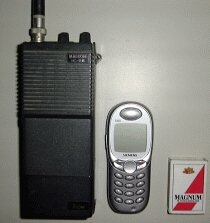In telecommunication, the term camp-on busy signal has the following meanings:
In telephony, the term local call has the following meanings:
- Any call using a single switching center; that is, not traveling to another telephone network;
- A call made within a local calling area as defined by the local exchange carrier;
- Any call for which an additional charge, i.e., toll charge, is not billed to the calling or called party, or for which this charge is reduced because it is a short-distance call.
In telephony, on-hook and off-hook are two states of a communication circuit. On subscriber telephones the states are produced by placing the handset onto or off the hookswitch. Placing the circuit into the off-hook state is also called seizing the line. Off-hook originally referred to the condition that prevailed when telephones had a separate earpiece (receiver), which hung from its switchhook until the user initiated a telephone call by removing it. When off hook the weight of the receiver no longer depresses the spring-loaded switchhook, thereby connecting the instrument to the telephone line.
In telecommunication, a private line is typically a telephone company service that uses a dedicated, usually unswitched point-to-point circuit, but it may involve private switching arrangements, or predefined transmission physical or virtual paths. Most private lines connect only two locations, but some have multiple drop points. If the circuit is used for interconnecting switching systems, including manual switchboards, it is often called a tie line.
In telecommunications, proceed-to-select is a signal or event in the call-access phase of a data call, which signal or event confirms the reception of a call-request signal and advises the calling data terminal equipment to proceed with the transmission of the selection signals.
In telephony, ringdown is a method of signaling an operator in which telephone ringing current is sent over the line to operate a lamp or cause the operation of a self-locking relay known as a drop.
In telecommunication, signaling is the use of signals for controlling communications. This may constitute an information exchange concerning the establishment and control of a telecommunication circuit and the management of the network.
Phreaking is a slang term coined to describe the activity of a culture of people who study, experiment with, or explore telecommunication systems, such as equipment and systems connected to public telephone networks. The term phreak is a sensational spelling of the word freak with the ph- from phone, and may also refer to the use of various audio frequencies to manipulate a phone system. Phreak, phreaker, or phone phreak are names used for and by individuals who participate in phreaking.
Wiretapping, also known as wire tapping or telephone tapping, is the monitoring of telephone and Internet-based conversations by a third party, often by covert means. The wire tap received its name because, historically, the monitoring connection was an actual electrical tap on an analog telephone or telegraph line. Legal wiretapping by a government agency is also called lawful interception. Passive wiretapping monitors or records the traffic, while active wiretapping alters or otherwise affects it.

A radiotelephone, abbreviated RT, is a radio communication system for conducting a conversation; radiotelephony means telephony by radio. It is in contrast to radiotelegraphy, which is radio transmission of telegrams (messages), or television, transmission of moving pictures and sound. The term is related to radio broadcasting, which transmit audio one way to listeners. Radiotelephony refers specifically to two-way radio systems for bidirectional person-to-person voice communication between separated users, such as CB radio or marine radio. In spite of the name, radiotelephony systems are not necessarily connected to or have anything to do with the telephone network, and in some radio services, including GMRS, interconnection is prohibited.
A busy signal in telephony is an audible call-progress tone or audible signal to the calling party that indicates failure to complete the requested connection of that particular telephone call.

A telephone call or telephone conversation, also known as a phone call or voice call, is a connection over a telephone network between the called party and the calling party. Telephone calls started in the late 19th century. As technology has improved, a majority of telephone calls are made over a cellular network through mobile phones or over the internet with Voice over IP. Telephone calls are typically used for real-time conversation between two or more parties, especially when the parties cannot meet in person.
A vertical service code (VSC) is a sequence of digits and the signals star (*) and pound/hash (#) dialed on a telephone keypad or rotary dial to access certain telephone service features. Some vertical service codes require dialing of a telephone number after the code sequence. On a touch tone telephone, the codes are usually initiated with the star key, resulting in the commonly used name star codes. On rotary dial telephones, the star is replaced by dialing 11.
In telecommunications, trunking is a technology for providing network access to multiple clients simultaneously by sharing a set of circuits, carriers, channels, or frequencies, instead of providing individual circuits or channels for each client. This is reminiscent to the structure of a tree with one trunk and many branches. Trunking in telecommunication originated in telegraphy, and later in telephone systems where a trunk line is a communications channel between telephone exchanges.
In telephony, call progress tones are audible tones that provide an indication of the status of a telephone call to the user. The tones are generated by a central office or a private branch exchange (PBX) to the calling party.
Voice logging is the practice of regularly recording telephone conversations. Business sectors which often do voice logging include public safety, customer service call centers, and finance. Although voice logging is usually performed on conventional telephone lines, it is also frequently used for recording open microphones and for broadcast radio.
Telephone call recording laws are legislation enacted in many jurisdictions, such as countries, states, provinces, that regulate the practice of telephone call recording. Call recording or monitoring is permitted or restricted with various levels of privacy protection, law enforcement requirements, anti-fraud measures, or individual party consent.

A telephone exchange, also known as a telephone switch or central office, is a crucial component in the public switched telephone network (PSTN) or large enterprise telecommunications systems. It facilitates the interconnection of telephone subscriber lines or digital system virtual circuits, enabling telephone calls between subscribers.

Call recording hardware, or a telephone recorder, is hardware that can be used to record telephone conversations. Call recording hardware is most often used by law enforcement, lawyers, journalist, and call centers to record phone transaction with customers.
Continuous redial, busy number redial, or repeat dial is a vertical service code that allows callers to automatically redial a busy telephone number until a connection is made. It was introduced in 1992 as Repeat Dialing, and is activated by dialing a combination of special characters and numbers after hanging up following a call to a busy line. It will run for a set period of time and can be deactivated by entering either the same set of numbers or a different set. The North American Numbering Plan assigned *66 to activate continuous redial and *86 to deactivate it.



